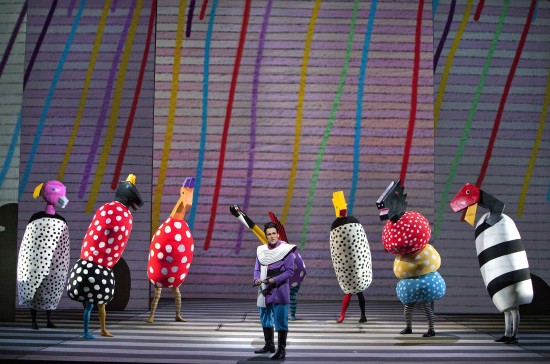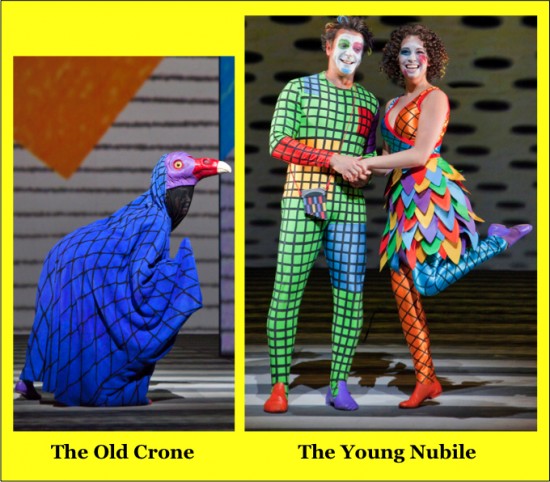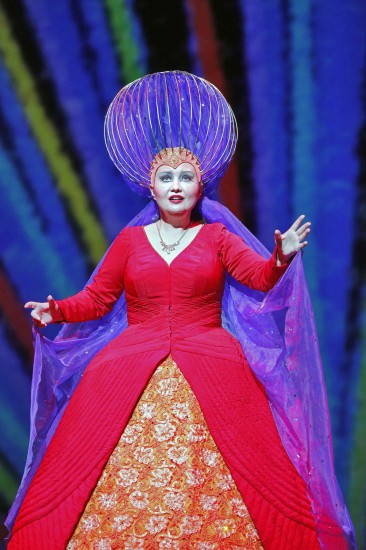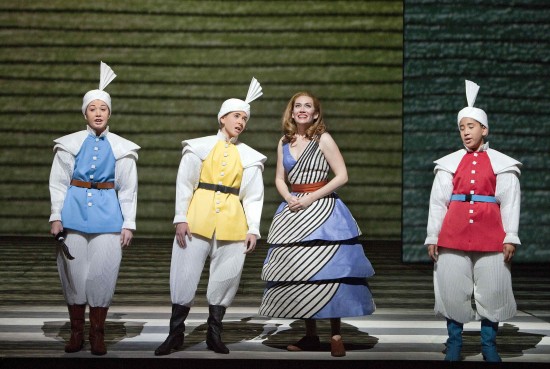Let me begin by quoting extensively from the note by Director Harry Silverstein which appeared in the program and is also on SF Opera’s website. (Scroll down and click on “Program Articles”)
As a director I hope to understand what the composer and librettist wish to communicate with their original work and then interpret it in a way that is at once vital and clear, as well as exciting and entertaining to the public who come to experience it.
On this project I worked with a spectacularly talented fine artist, Jun Kaneko, and I had two responsibilities�to help inform the design process and its transfer to the stage, and to make certain that the story and music are one with that design. Jun has created a series of fantastic abstract animations, based on his elegant painting style and reflecting the emotions of the music, to create a thrilling setting using the most current projection technology. These animations are truly an innovative way of operatic storytelling, and we have aspired to create staging that is not in contrast or concurrent with the animations, but in concert with them. The goal of each aspect of this production has been inspired by and, hopefully, in service of the music.

Rene� Tatum, Lauren McNeese and Melody Moore (The Three Ladies), the animated monster, and Alek Shrader (Tamino)
Noble goals, with which I agree 100%. And in my personal opinion, he totally succeeded. Any way you want to look at, I have never seen a better performance of Mozart’s The Magic Flute.
The task is not simple, and it requires choices and trade-offs. Consider first the choice of language. Mozart wrote in a language that had three important characteristics:
- It was 17th century German,
- It was the current spoken language of the audience
- It fit the music
The audience last night (June 22, 2012) was primarily 21st century American – or more specifically 21stcentury Californian – so that attributes 1 and 2 above are mutually exclusive. For most operas the decision is to honor #1 (which automatically includes #3), and show supertitles in English. However, The Magic Flute is written in singspiel format with lots of spoken dialog. Particularly for the role of Papageno, this involves humorous dialog along with relevant action – and the great tall stage area of War Memorial Theatre precludes focusing on both stage and supertitles at the same time.
Anyhow, putting the whole thing into contemporary California worked perfectly last night and provoked several appreciative chuckles from the audience. To quote just a couple of examples: When asked who he is, Papageno replies that he “engages in sustainable bird-catching.” Near the end when Monastatos is foiled in his lecherous plans for Pamina, he says, “I guess I’ll go hit on her mother – she’s one hot lady.”
Probably the most controversial feature of the production was the complete reliance on a few moveable screens with projected colors, designs, and animations for the stage settings – there was no need whatever for a stage construction crew. I thought that it was all done perfectly. When stage action was hot and heavy, I was not conscious of the stage setting, but no part of my mind detected any incongruities. I said as much to Sara, who is much more sophisticated musically than I am, during the intermission, and she strongly disagreed. She liked the colors and designs, but found the animation detracted greatly from her appreciation of the music. I was a bit more critical during the second act and found that when I looked for them the moving lines and shapes did not enhance the music – but unless I was specifically concentrating on the motion, I didn’t find it at all distracting.
The Magic Flute is set in a magical never-never land, independent of any specific geographical area or historical epoch, and the surrealistic costumes with bold colors seemed perfect for that setting – as did the various critters. The monster that threatened Tamino at the very beginning of the opera was a fearsome two-head mechanical beast with long snake-like necks, controlled by semi-invisible stagehands with the same skill shown in manipulating the wondress elephant in last year’s Aida. Various weird birds wandered on and off stage during Papageno’s introductory aria, and the collection of animals that gathered to hear Tamino’s flute playing were not modeled from any real bestiary.
And Papagena’s transformation from an Old Crone to a Young Nubile is about as dramatic as any I’ve ever seen.
A charming touch is added in the love-scene between Papageno and Papagena as they are singing about all the children they will have. One by one cute little chicks dance on stage and circle around with little flaps of their wings. At the end of the scene they all exit together in pell-mell fashion – except the littlest chick who remains rooted to the floor until Papagena returns and herds her off. Anyone who has watched a pre-school child or grandchild in a ballet class recital can attest to the realism of that scene.
The singing ranged from excellent to out-of-this-world. Kristinn Sigmundsson’s Sarastro hit his lowest bass notes with satisfying sonority. His impressive stature didn’t hurt, either.
In his delightful book A Night at the Opera, Denis Forman describes The Queen of the Night’s famous aria in Act I as “tough vocal gymnastics for the Queen – if she wins, magic; if she is struggling, quite awful, like a Monday morning singing lesson in Aberdeen.” Of her Act II aria, “This remarkable and very difficult piece is a knockout if the singer can ride it with ease and conviction. This does not always happen.” There is no question that Russian-born soprano Albina Shagimuratova passed both tests with flying colors. I have never heard mid-act applause as loud and as long as that given by the audience as she exited in Act II.
The acting was also first-rate. Papageno was all over the stage and mastered the sudden transformations between bravado and cowardice. Monostatos was a great comic villain; he and Papageno interacted with perfect timing in the scene where the two of them each think the other must be the Devil.
This is only the second time I have seen Heidi Stober in San Francisco – but I hope it won’t be the last. I loved her as Sophie in Werther and last night she was irresistible in the lead role of Pamina. I can barely see her facial expression from Row R, but her body-language tells it all. She is so alive – so into the part. When she is happy, she quivers with joy; when she is sad she droops with misery.
I don’t know if it was by design or a happy coincidence, but the combination of her hairdo, her costumes, and her posture reminded me of Alice in John Tenniel’s original drawings for Lewis Carroll’s Alice in Wonderland. Anyhow, it seemed a most apt comparison.

Heidi Stober (Pamina) and Alek Shrader (Tamino) with chorus of priests and priestesses in opera finale
As of today there are 5 remaining performances before it closes with a July 8 Matinee. Get on the phone or the web and get your ticket. For detailed information and to buy tickets go to San Francisco Summer 2012.
San Francisco Opera
301 Van Ness Avenue
San Francisco, CA 94102
(415) 861-4008
sfopera.com
Except as noted, all photos by Cory Weaver, San Francisco Opera
This review by Philip G Hodge appeared in sanfranciscosplash.com on June 27, 2012.










